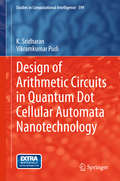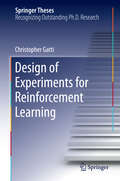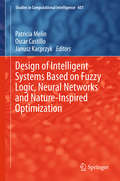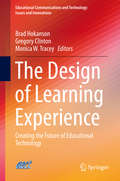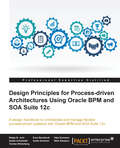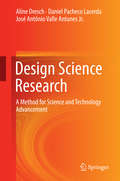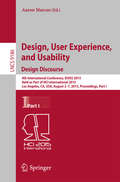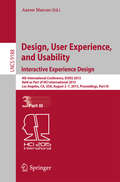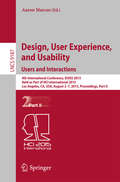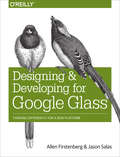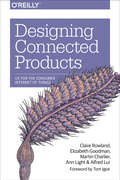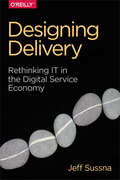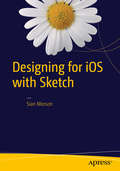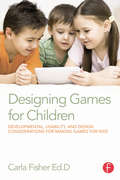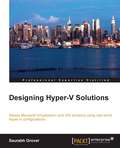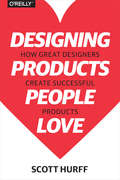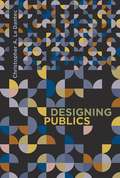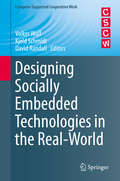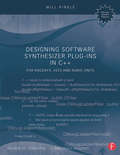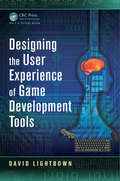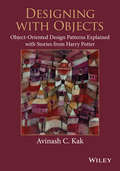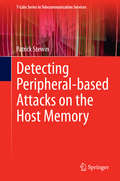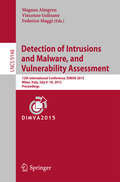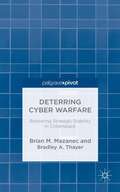- Table View
- List View
Design of Arithmetic Circuits in Quantum Dot Cellular Automata Nanotechnology
by K. Sridharan Vikramkumar PudiThis research monograph focuses on the design of arithmetic circuits in Quantum Dot Cellular Automata (QCA). Using the fact that the 3-input majority gate is a primitive in QCA, the book sets out to discover hitherto unknown properties of majority logic in the context of arithmetic circuit designs. The pursuit for efficient adders in QCA takes two forms. One involves application of the new results in majority logic to existing adders. The second involves development of a custom adder for QCA technology. A QCA adder named as hybrid adder is proposed and it is shown that it outperforms existing multi-bit adders with respect to area and delay. The work is extended to the design of a low-complexity multiplier for signed numbers in QCA. Furthermore the book explores two aspects unique to QCA technology, namely thermal robustness and the role of interconnects. In addition, the book introduces the reader to QCA layout design and simulation using QCADesigner. Features & Benefits: This research-based book: ·Introduces the reader to Quantum Dot Cellular Automata, an emerging nanotechnology. ·Explores properties of majority logic. ·Demonstrates application of the properties to design efficient arithmetic circuits. ·Guides the reader towards layout design and simulation in QCADesigner.
Design of Experiments for Reinforcement Learning
by Christopher GattiThis thesis takes an empirical approach to understanding of the behavior and interactions between the two main components of reinforcement learning: the learning algorithm and the functional representation of learned knowledge. The author approaches these entities using design of experiments not commonly employed to study machine learning methods. The results outlined in this work provide insight as to what enables and what has an effect on successful reinforcement learning implementations so that this learning method can be applied to more challenging problems.
Design of Intelligent Systems Based on Fuzzy Logic, Neural Networks and Nature-Inspired Optimization
by Patricia Melin Oscar Castillo Janusz KacprzykThis book presents recent advances on the design of intelligent systems based on fuzzy logic, neural networks and nature-inspired optimization and their application in areas such as, intelligent control and robotics, pattern recognition, time series prediction and optimization of complex problems. The book is organized in eight main parts, which contain a group of papers around a similar subject. The first part consists of papers with the main theme of theoretical aspects of fuzzy logic, which basically consists of papers that propose new concepts and algorithms based on fuzzy systems. The second part contains papers with the main theme of neural networks theory, which are basically papers dealing with new concepts and algorithms in neural networks. The third part contains papers describing applications of neural networks in diverse areas, such as time series prediction and pattern recognition. The fourth part contains papers describing new nature-inspired optimization algorithms. The fifth part presents diverse applications of nature-inspired optimization algorithms. The sixth part contains papers describing new optimization algorithms. The seventh part contains papers describing applications of fuzzy logic in diverse areas, such as time series prediction and pattern recognition. Finally, the eighth part contains papers that present enhancements to meta-heuristics based on fuzzy logic techniques.
The Design of Learning Experience
by Brad Hokanson Gregory Clinton Monica W. TraceyThis book delves into two divergent, yet parallel themes; first is an examination of how educators can design the experiences of learning, with a focus on the learner and the end results of education; and second, how educators learn to design educational products, processes and experiences. The book seeks to understand how to design how learning occurs, both in the instructional design studio and as learning occurs throughout the world. This will change the area's semantics; at a deeper level, it will change its orientation from instructors and information to learners; and it will change how educators take advantage of new and old technologies. This book is the result of a research symposium sponsored by the Association for Educational Communications and Technology [AECT].
Design Principles for Process-driven Architectures Using Oracle BPM and SOA Suite 12c
by Matjaz B. Juric Sven BernhardtThis book is intended for BPM and SOA architects, analysts, developers, and project managers who are responsible for, or involved in, business process development, modelling, monitoring, or the implementation of composite, process-oriented applications. The principles are relevant for the design of on-premise and cloud solutions.
Design Science Research
by Aline Dresch Daniel Pacheco Lacerda José Antônio Valle AntunesConsolidating existing knowledge in Design Science, this book proposes a new research method to aid the exploration of design and problem solving within business, science and technology. It seeks to overcome a dichotomy that exists in the field between theory and practice to enable researches to find solutions to problems, rather than focusing on the explanation and exploration of the problems themselves. Currently, researches concentrate on to describing, exploring, explaining and predicting phenomena, and little attention is devoted to prescribing solutions. Herbert Simon proposes the need to develop a Science of the Artificial (Design Science), arguing that our reality is much more artificial than natural. However, the research conducted on the Design Science premises has so far been scattered and erratic in different fields of research, such as management, systems information and engineering. This book aims to address this issue by bringing these fields together and emphasising the need for solutions. This book provides a valuable resource to students and researchers of research methods, information systems, management and management science, and production and operations management.
Design, User Experience, and Usability: Design Discourse
by Aaron MarcusThe three-volume set LNCS 9186, 9187, and 9188 constitutes the proceedings of the 4th International Conference on Design, User Experience, and Usability, DUXU 2015, held as part of the 17th International Conference on Human-Computer Interaction, HCII 2015, in Los Angeles, CA, USA, in August 2015, jointly with 13 other thematically similar conferences. The total of 1462 papers and 246 posters presented at the HCII 2015 conferences were carefully reviewed and selected from 4843 submissions. These papers address the latest research and development efforts and highlight the human aspects of design and use of computing systems. The papers accepted for presentation thoroughly cover the entire field of Human-Computer Interaction, addressing major advances in knowledge and effective use of computers in a variety of application areas. The total of 132 contributions included in the DUXU proceedings were carefully reviewed and selected for inclusion in this three-volume set. The 61 papers included in this volume are organized in topical sections on design thinking, user experience design and usability methods and tools, DUXU management and practice, emotional and persuasion design, and storytelling, narrative and fiction in DUXU.
Design, User Experience, and Usability: Interactive Experience Design
by Aaron MarcusThe three-volume set LNCS 9186, 9187, and 9188 constitutes the proceedings of the 4th International Conference on Design, User Experience, and Usability, DUXU 2015, held as part of the 17th International Conference on Human-Computer Interaction, HCII 2015, in Los Angeles, CA, USA, in August 2015, jointly with 13 other thematically similar conferences. The total of 1462 papers and 246 posters presented at the HCII 2015 conferences were carefully reviewed and selected from 4843 submissions. These papers address the latest research and development efforts and highlight the human aspects of design and use of computing systems. The papers accepted for presentation thoroughly cover the entire field of Human-Computer Interaction, addressing major advances in knowledge and effective use of computers in a variety of application areas. The total of 132 contributions included in the DUXU proceedings were carefully reviewed and selected for inclusion in this three-volume set. The 64 papers included in this volume are organized in topical sections on designing the social media experience, designing the learning experience, designing the playing experience, designing the urban experience, designing the driving experience, designing the healthcare patient's experience, and designing for the healthcare professional's experience.
Design, User Experience, and Usability: Users and Interactions
by Aaron MarcusThe three-volume set LNCS 9186, 9187, and 9188 constitutes the proceedings of the 4th International Conference on Design, User Experience, and Usability, DUXU 2015, held as part of the 17th International Conference on Human-Computer Interaction, HCII 2015, in Los Angeles, CA, USA, in August 2015, jointly with 13 other thematically similar conferences. The total of 1462 papers and 246 posters presented at the HCII 2015 conferences were carefully reviewed and selected from 4843 submissions. These papers address the latest research and development efforts and highlight the human aspects of design and use of computing systems. The papers accepted for presentation thoroughly cover the entire field of Human-Computer Interaction, addressing major advances in knowledge and effective use of computers in a variety of application areas. The total of 132 contributions included in the DUXU proceedings were carefully reviewed and selected for inclusion in this three-volume set. The 67 papers included in this volume are organized in topical sections on users in DUXU, women in DUXU, information design, touch and gesture DUXU, mobile DUXU, and wearable DUXU.
Design, User Experience, and Usability: 4th International Conference, DUXU 2015, Held as Part of HCI International 2015, Los Angeles, CA, USA, August 2-7, 2015, Proceedings, Part I (Lecture Notes in Computer Science #9186)
by Aaron MarcusThe three-volume set LNCS 9186, 9187, and 9188 constitutes the proceedings of the 4th International Conference on Design, User Experience, and Usability, DUXU 2015, held as part of the 17th International Conference on Human-Computer Interaction, HCII 2015, in Los Angeles, CA, USA, in August 2015, jointly with 13 other thematically similar conferences. The total of 1462 papers and 246 posters presented at the HCII 2015 conferences were carefully reviewed and selected from 4843 submissions. These papers address the latest research and development efforts and highlight the human aspects of design and use of computing systems. The papers accepted for presentation thoroughly cover the entire field of Human-Computer Interaction, addressing major advances in knowledge and effective use of computers in a variety of application areas. The total of 132 contributions included in the DUXU proceedings were carefully reviewed and selected for inclusion in this three-volume set. The 61 papers included in this volume are organized in topical sections on design thinking, user experience design and usability methods and tools, DUXU management and practice, emotional and persuasion design, and storytelling, narrative and fiction in DUXU.
Designing and Developing for Google Glass
by Jason Salas Allen FirstenbergCreating apps for Google Glass is more involved than simply learning how to navigate its hardware, APIs, and SDK. You also need the right mindset. While this practical book delivers the information and techniques you need to build and deploy Glass applications, it also helps you to think for Glass by showing you how the platform works in, and affects, its environment.In three parts--Discover, Design, and Develop--Glass pioneers guide you through the Glass ecosystem and demonstrate what this wearable computer means for users, developers, and society as a whole. You'll learn how to create rich functionality for a consumer technology that's radically different than anything currently available.Learn the Five Noble Truths of great Glassware designUnderstand the Glass ecosystem and learn why it's differentSidestep Glass's societal concerns in your projectsLearn how Glass adapts to the user's world, rather than the other way aroundAvoid poor design by identifying Glassware antipatternsBuild cloud services with the Google Mirror APIUse the Glass Development Kit to develop client applicationsSubmit your project for review in the MyGlass directory
Designing Connected Products: UX for the Consumer Internet of Things
by Elizabeth Goodman Claire Rowland Martin Charlier Ann Light Alfred LuiNetworked thermostats, fitness monitors, and door locks show that the Internet of Things can (and will) enable new ways for people to interact with the world around them. But designing connected products for consumers brings new challenges beyond conventional software UI and interaction design.This book provides experienced UX designers and technologists with a clear and practical roadmap for approaching consumer product strategy and design in this novel market. By drawing on the best of current design practice and academic research, Designing Connected Products delivers sound advice for working with cross-device interactions and the complex ecosystems inherent in IoT technology.
Designing Delivery
by Jeff SussnaNow that we're moving from a product economy to a digital service economy, software is becoming critical for navigating our everyday lives. The quality of your service depends on how well it helps customers accomplish goals and satisfy needs. Service quality is not about designing capabilities, but about making--and keeping--promises to customers.To help you improve customer satisfaction and create positive brand experiences, this pragmatic book introduces a transdisciplinary approach to digital service delivery. Designing a resilient service today requires a unified effort across front-office and back-office functions and technical and business perspectives. You'll learn how make IT a full partner in the ongoing conversations you have with your customers.Take a unique customer-centered approach to the entire service delivery lifecycleApply this perspective across development, operations, QA, design, project management, and marketingImplement a specific quality assurance methodology that unifies those disciplinesUse the methodology to achieve true resilience, not just stability
Designing for iOS with Sketch
by Sian MorsonDesigning for iOS with Sketch takes you through the process of designing your iOS app using Bohemian Code's Sketch. Sketch is a powerful new design program that is quickly replacing Adobe PhotoShop for many designers designing for mobile apps and the mobile web. This book will introduce you to the program and then take you through the steps of designing your very own app. It includes examples and shortcuts as well as a helpful list of plugins and 3rd party resources that will greatly improve your workflow. What you'll learn What sets Sketch apart from PhotoShop and Illustrator Use Sketch to design a simple iOS app Learn helpful shortcuts to speed up your workflow Get a helpful list of resources from around the web Includes a list of plugins to extend Sketch and make designing more fun Who this book is for Beginning to intermediate iOS app designers who are looking for an alternative to PhotoShop. Table of Contents Chapter 1: Why Sketch? Chapter 2: The Sketch Interface Chapter 3: Shapes and Styles Chapter 4: Symbols Chapter 5: Text and Fonts Chapter 6: Optimizing Your Workflow Chapter 7: Creating a Simple App Chapter 8: Creating an Icon Chapter 9: Exporting Assets for Development Chapter 10: Sketch Resources and Plugins
Designing Games for Children: Developmental, Usability, and Design Considerations for Making Games for Kids
by Carla FisherWhen making games for kids, it’s tempting to simply wing-it on the design. We were all children once, right? The reality is that adults are far removed from the cognitive changes and the motor skill challenges that are the hallmark of the developing child. Designing Games for Children, helps you understand these developmental needs of children and how to effectively apply them to games. <P><P> Whether you’re a seasoned game designer, a children's media professional, or an instructor teaching the next generation of game designers, Designing Games for Children is the first book dedicated to service the specific needs of children's game designers. This is a hands-on manual of child psychology as it relates to game design and the common challenges designers face. <P><P> Designing Games for Children is the definitive, comprehensive guide to making great games for kids, featuring: <li> Guidelines and recommendations divided by the most common target audiences – babies and toddlers (0-2), preschoolers (3-5), early elementary students (6-8), and tweens (9-12). <li> Approachable and actionable breakdown of child developmental psychology, including cognitive, physical, social, and emotional development, as it applies to game design <li> Game design insights and guidelines for all aspects of game production, from ideation to marketing
Designing Hyper-V Solutions
by Saurabh GroverThis book is aimed at IT admins, consultants, and architects alike who wish to deploy, manage, and maintain Hyper-V solutions in organizations of various sizes. You are expected to have a working knowledge of managing Windows Server and a fair understanding of networking and storage concepts.
Designing Products People Love
by Scott HurffHow can you create products that successfully find customers? With this practical book, you'll learn from some of the best product designers in the field, from companies like Facebook and LinkedIn to up-and-coming contenders. You'll understand how to discover and interpret customer pain, and learn how to use this research to guide your team through each step of product creation.Written for designers, product managers, and others who want to communicate better with designers, this book is essential reading for anyone who contributes to the product creation process.Understand exactly who your customers are, what they want, and how to build products that make them happyLearn frameworks and principles that successful product designers useIncorporate five states into every screen of your interface to improve conversions and reduce perceived loading timesDiscover meeting techniques that Apple, Amazon, and LinkedIn use to help teams solve the right problems and make decisions fasterDesign effective interfaces across different form factors by understanding how people hold devices and complete tasksLearn how successful designers create working prototypes that capture essential customer feedbackCreate habit-forming and emotionally engaging experiences, using the latest psychological research
Designing Publics
by Christopher A. Le DantecContemporary computing technologies have thoroughly embedded themselves in every aspect of modern life -- conducting commerce, maintaining and extending our networks of friends, and mobilizing political movements all occur through a growing collection of devices and services designed to keep and hold our attention. Yet what happens when our attention needs to be more local, collective, and focused on our immediate communities? Perhaps more important, how can we imagine and create new technologies with local communities? In Designing Publics, Christopher Le Dantec explores these questions by designing technologies with the urban homeless. Drawing on a case study of the design of a computational infrastructure in a shelter for homeless women and their children, Le Dantec theorizes an alternate vision of design in community contexts.Focusing on collective action through design, Le Dantec investigates the way design can draw people together on social issues and create and sustain a public. By "designing publics" he refers both to the way publics arise out of design intervention and to the generative action publics take -- how they "do design" as they mobilize and act in the world. This double lens offers a new view of how design and a diverse set of design practices circulate in sites of collective action rather than commercial production.
Designing Socially Embedded Technologies in the Real-World
by Volker Wulf Kjeld Schmidt David RandallThis book is concerned with the associated issues between the differing paradigms of academic and organizational computing infrastructures. Driven by the increasing impact Information Communication Technology (ICT) has on our working and social lives, researchers within the Computer Supported Cooperative Work (CSCW) field try and find ways to situate new hardware and software in rapidly changing socio-digital ecologies. Adopting a design-orientated research perspective, researchers from the European Society for Socially Embedded Technologies (EUSSET) elaborate on the challenges and opportunities we face through the increasing permeation of society by ICT from commercial, academic, design and organizational perspectives. Designing Socially Embedded Technologies in the Real-World is directed at researchers, industry practitioners and will be of great interest to any other societal actors who are involved with the design of IT systems.
Designing Software Synthesizer Plug-Ins in C++: For RackAFX, VST3, and Audio Units
by Will PirkleBridging the gap from theory to programming, Designing Software Synthesizer Plug-Ins in C++ For RackAFX, VST3 and Audio Units contains complete code for designing and implementing software synthesizers for both Windows and Mac platforms. You will learn synthesizer operation, starting with the underlying theory of each synthesizer component, and moving on to the theory of how these components combine to form fully working musical instruments that function on a variety of target digital audio workstations (DAWs). Containing some of the latest advances in theory and algorithm development, this book contains information that has never been published in textbook form, including several unique algorithms of the author’s own design. The book is broken into three parts: plug-in programming, theory and design of the central synthesizer components of oscillators, envelope generators, and filters, and the design and implementation of six complete polyphonic software synthesizer musical instruments, which can be played in real time. The instruments implement advanced concepts including a user-programmable modulation matrix. The final chapter shows you the theory and code for a suite of delay effects to augment your synthesizers, introducing you to audio effect processing. The companion website, www.focalpress.com/cw/pirkle, gives you access to free software to guide you through the application of concepts discussed in the book, and code for both Windows and Mac platforms. In addition to the software, it features bonus projects, application notes, and video tutorials. A reader forum, monitored by the author, gives you the opportunity for questions and information exchange.
Designing the User Experience of Game Development Tools
by David LightbownMost tools developers want to improve the user experience but are not given the time, lack the techniques, or don't know where to begin.Designing the User Experience of Game Development Tools addresses these issues to empower tools developers to make positive steps toward improving the user experience of their tools.The book explains how to im
Designing with Objects
by Avinash C. Kak* All code examples in the book are available for download on a companion site with resources for readers and instructors* A refreshing alternative to the rather abstract and dry explanations of the object-oriented design patterns in much of the existing literature on the subject* In 24 chapters, Designing with Objects explains well-known design patterns by relating them to stories from the Harry Potter series
Detecting Peripheral-based Attacks on the Host Memory
by Patrick StewinThis work addresses stealthy peripheral-based attacks on host computers and presents a new approach to detecting them. Peripherals can be regarded as separate systems that have a dedicated processor and dedicated runtime memory to handle their tasks. The book addresses the problem that peripherals generally communicate with the host via the host's main memory, storing cryptographic keys, passwords, opened files and other sensitive data in the process - an aspect attackers are quick to exploit. Here, stealthy malicious software based on isolated micro-controllers is implemented to conduct an attack analysis, the results of which provide the basis for developing a novel runtime detector. The detector reveals stealthy peripheral-based attacks on the host's main memory by exploiting certain hardware properties, while a permanent and resource-efficient measurement strategy ensures that the detector is also capable of detecting transient attacks, which can otherwise succeed when the applied strategy only measures intermittently. Attackers exploit this strategy by attacking the system in between two measurements and erasing all traces of the attack before the system is measured again.
Detection of Intrusions and Malware, and Vulnerability Assessment
by Magnus Almgren Vincenzo Gulisano Federico MaggiThis book constitutes the refereed proceedings of the 12th International Conference on Detection of Intrusions and Malware, and Vulnerability Assessment, DIMVA 2015, held in Milan, Italy, in July 2015. The 17 revised full papers presented were carefully reviewed and selected from 75 submissions. The papers are organized in topical sections on attacks, attack detection, binary analysis and mobile malware protection, social networks and large-scale attacks, Web and mobile security, and provenance and data sharing.
Deterring Cyber Warfare: Bolstering Strategic Stability in Cyberspace
by Brian M. Mazanec Bradley A. ThayerWhile the deterrence of cyber attacks is one of the most important issues facing the United States and other nations, the application of deterrence theory to the cyber realm is problematic. This study introduces cyber warfare and reviews the challenges associated with deterring cyber attacks, offering key recommendations to aid the deterrence of major cyber attacks.
